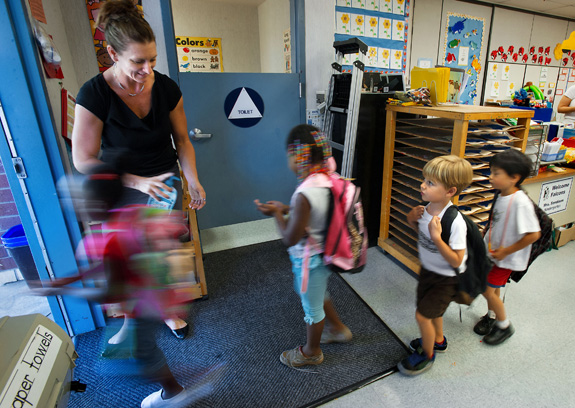Inclusion Rates For Special Education Students Vary By State

A new analysis finds that whether or not students with autism attend mainstream classes depends — at least in part — on what state they live in. (Randall Benton/Sacramento Bee/MCT)
Where a child lives may significantly impact whether they are placed in an inclusive or segregated classroom, a new national analysis suggests.
Regional differences appear to play a role in education placements for students with autism, with those living in the West more likely to attend mainstream classes while students in the Eastern United States are more frequently assigned to segregated settings, according to findings published online in the journal Focus on Autism and Other Developmental Disabilities.
For the study, Jennifer Kurth, an assistant professor of special education at the University of Kansas, combed through U.S. Department of Education data on placements for children with autism in the nation’s schools between 1998 and 2008.
Advertisement - Continue Reading Below
On average, about 37 percent of students on the spectrum spent at least 80 percent of their school day in inclusive environments. But the numbers varied considerably from one place to the next, ranging from just 8 percent in Washington, D.C. to 62 percent in Iowa.
Similarly, Kurth found extreme differences across the states in the number of students placed in self-contained classrooms and residential or otherwise separate schools.
“If child-specific factors were solely responsible for education placement decisions, one would expect states to have similar rates of inclusive, self-contained, mainstreaming and separate school placements for students with ASDs,” Kurth wrote. “Instead, … results indicate that educational placement varies by state.”
Overall, the analysis found that Colorado, Connecticut, Idaho, Iowa, Minnesota, Nebraska, North Dakota, West Virginia and Wisconsin most consistently favored inclusion.
In contrast, Alaska, Delaware, Florida, Hawaii, Louisiana, New Hampshire, New Jersey, New York, South Carolina and Washington, D.C. generally leaned toward restrictive settings.
When funding formulas for each state were examined, Kurth found that a handful of states appeared to incentivize placing students in more restrictive environments, but said that these monetary policies did not appear to have a “clear impact” on educational placement decisions.
Read more stories like this one. Sign up for Disability Scoop's free email newsletter to get the latest developmental disability news sent straight to your inbox.


